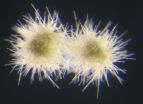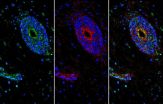(Press-News.org) Scientists have found something they can't quite explain in one of the most barren environments on Earth: a bacterium whose DNA sequence contains elements usually only found in a much higher organism.
Trichodesmium is a type of bacteria known as an oligotroph, meaning that it can survive in incredibly nutrient-poor regions of the ocean. In fact, it thrives there -- to the point that great blooms of the microorganism can be seen both with the naked eye and from satellites in space, earning it the name "sea sawdust" from ancient mariners.
This is because Trichodesmium is a "nitrogen fixer" -- it makes harsh environments more habitable by turning nitrogen gas from the air into ammonium, a nutrient that other organisms can use. It's foundational to the entire food web of the ocean and therefore an important organism for scientists to understand.
By sequencing multiple Trichodesmium genomes -- and using a wide variety of samples to ensure that there was no error -- researchers found that only about 63 percent of the bacteria's genome is expressed as protein. That's an incredibly low amount for a bacterium and unheard of for a free-living oligotroph.
"Our study adds another wrinkle to this enigmatic organism's story," said Eric Webb, associate professor at the USC Dornsife College of Letters, Arts and Sciences and corresponding author of a study on the finding.
In a paper published in March in the Proceedings of the National Academy of Sciences, Webb and his colleagues revealed that Trichodesmium's DNA defies common evolutionary dogma, meaning that there's either an important piece of the puzzle still missing or that the understanding of the evolution of microbial genomes needs to be revisited.
"The unique evolutionary path reflected in this genome contradicts nearly all accounts of free-living microbial genome architectures to date," said lead author Nathan Walworth, a Ph.D. candidate at USC. "Different evolutionary paths are foundational to all arenas of biology, including biotechnology, so it is important for the field to be cognizant of different paths a living organism can take to achieve ecological success."
When scientists first started sequencing genomes in the last century, they found that not every part of the DNA strand encoded a protein to be expressed. In fact, we now know that only about 2 percent of the human genome is expressed -- the rest was initially called "junk DNA."
Scientists now describe it as "non-coding DNA," a nod to the fact that functions have been defined for many of these regions; however, there is still controversy on the extent and role of these regions.
Despite the uncertainty, higher organisms -- like humans -- with tiny populations are highly vulnerable to sweeping mutations and thus can contain a lot of non-coding DNA.
Lower organisms with huge populations -- like bacteria -- are far less susceptible to sweeping mutations and accordingly have been shown to have genomes that are about 85 percent protein coding.
Oligotrophs, in particular, shun non-coding DNA, possibly because of the high energy-cost of living in a harsh environment. Cells need every ounce of energy simply to replicate and survive.
Trichodesmium, as Webb and his team discovered, breaks the mold. Yet despite the novelty of the finding, the ultimate cause of the large non-coding space remains to be defined.
The team theorizes that the high level of non-coding DNA is likely the result of a combination of factors, possibly including the way that Trichodesmium blooms.
Blooms make the species more vulnerable to genetic drift and can lead to genomes with enriched non-coding DNA.
"However, since there are many other bloom-forming cyanobacteria that that do not have expanded non-coding space, blooming ecology is likely not the whole story," Webb said. "Right now, we speculate that interactions with other undefined organisms might also be important."
The surprising and odd nature of Trichodesmium's DNA represents a new and open issue in the study of genetics and one, given the organism's overall importance, that the researchers are eager to answer.
INFORMATION:
The study was completed by scientists from USC, the University of Freiburg in Germany, the Pacific Northwest National Laboratory, the Woods Hole Oceanographic Institution, the Joint Genome Institute and the Oak Ridge National Laboratory. The research was funded by the National Science Foundation (OCE-1260490).
A new type of graphene aerogel will make for better energy storage, sensors, nanoelectronics, catalysis and separations.
Lawrence Livermore National Laboratory researchers have made graphene aerogel microlattices with an engineered architecture via a 3D printing technique known as direct ink writing. The research appears in the April 22 edition of the journal, Nature Communications.
The 3D printed graphene aerogels have high surface area, excellent electrical conductivity, are lightweight, have mechanical stiffness and exhibit supercompressibility (up to 90 percent ...
Montréal, April 22, 2015 - Researchers at the IRCM led by Artur Kania, PhD, uncovered the critical role in pain processing of a gene associated with a rare disease. Their breakthrough, published in The Journal of Neuroscience, paves the way for a better understanding of chronic pain conditions.
Dr. Kania's team studies the way neural circuits transform harmful stimuli (such as cold, heat, and pinch) into the perception of pain. More precisely, they examined the gene Lmx1b and its involvement in pain processing. Mutations in this gene also cause a rare human disease ...
PHILADELPHIA - In the first major study to examine the use of a computer-assisted, photo-driven differential diagnosis generator for skin conditions, researchers at the Perelman School of Medicine at the University of Pennsylvania found physicians routinely used the tool, without an increase in calling for inpatient dermatology consultations. The software diagnostic tool, VisualDx, aids in diagnosing dermatologic conditions by allowing physicians to enter information such as the type and location of a rash, and associated symptoms such as pain or itching, and then generating ...
SAN FRANCISCO--It may seem unlikely that a large earthquake would take place hundreds of kilometers away from a tectonic plate boundary, in areas with low levels of strain on the crust from tectonic motion. But major earthquakes such as the Mw 7.9 2008 Chengdu quake in China and New Zealand's 2011 Mw 6.3 quake have shown that large earthquakes do occur and can cause significant infrastructure damage and loss of life. So what should seismologists look for if they want to identify where an earthquake might happen despite the absence of historical seismic activity?
Roger ...
COLUMBUS, Ohio - Researchers have uncovered the first evidence of a genetic link between prodigy and autism.
The scientists found that child prodigies in their sample share some of the same genetic variations with people who have autism.
These shared genetic markers occur on chromosome 1, according to the researchers from The Ohio State University and Nationwide Children's Hospital in Columbus.
The findings confirm a hypothesis made by Joanne Ruthsatz, co-author of the study and assistant professor of psychology at Ohio State's Mansfield campus.
In a previous study, ...
WASHINGTON - Vehicle cost, current battery technology, and inadequate consumer knowledge are some of the barriers preventing widespread adoption of plug-in electric vehicles, says a new congressionally mandated report from the National Research Council. Developing less expensive, better performing batteries is essential to reducing overall vehicle cost, and a market strategy is needed to create awareness and overcome customer uncertainty. The report recommends a range of incentives that the federal government can offer to address these and other barriers.
The report ...
The brain is a privileged organ in the body. So vital to life, the brain is protected from alterations elsewhere in the body by a highly regulated gateway known as the blood-brain barrier, which allows only selected molecules to pass through.
In certain diseases, however, such as multiple sclerosis, the barrier can be improperly breached. These "leaks" can allow immune cells and inflammatory molecules to pass through, causing inflammation that leads to neuronal damage.
In a new study, researchers have made insights into how the blood-brain barrier, or BBB, is maintained, ...
The widespread use of cloth masks by healthcare workers may actually put them at increased risk of respiratory illness and viral infections and their global use should be discouraged, according to a UNSW study.
The results of the first randomised clinical trial (RCT) to study the efficacy of cloth masks were published today in the journal BMJ Open.
The trial saw 1607 hospital healthcare workers across 14 hospitals in the Vietnamese capital, Hanoi, split into three groups: those wearing medical masks, those wearing cloth masks and a control group based on usual practice, ...
(Boston)-- Individuals with mild Traumatic Brain Injury (mTBI), particularly those who have had loss of consciousness (LOC), show structural brain abnormalities in their white matter as measured by Diffusion Tensor Imaging (DTI).
These findings, which appear in the journal NeuroImage: Clinical, is the only study to date to demonstrate that mTBI with LOC is associated with brain abnormalities that lead to decreased performance in verbal memory.
Blast-related TBI has been a common injury among returning troops due to the widespread use of improvised explosive devices ...
WASHINGTON (April 22, 2015) -- New research published this week in Nature has found several drugs could lead to new treatment options for multiple sclerosis (MS), including two drugs that effectively treat MS at the source, in vivo. When administered at the peak of disease, these two drugs showed a striking reversal of disease severity.
At the pathological level, MS is a disease in which the immune system attacks the protective myelin sheath, a type of insulation that covers nerves, ultimately disrupting communication between the brain and the body and leading to nerve ...

